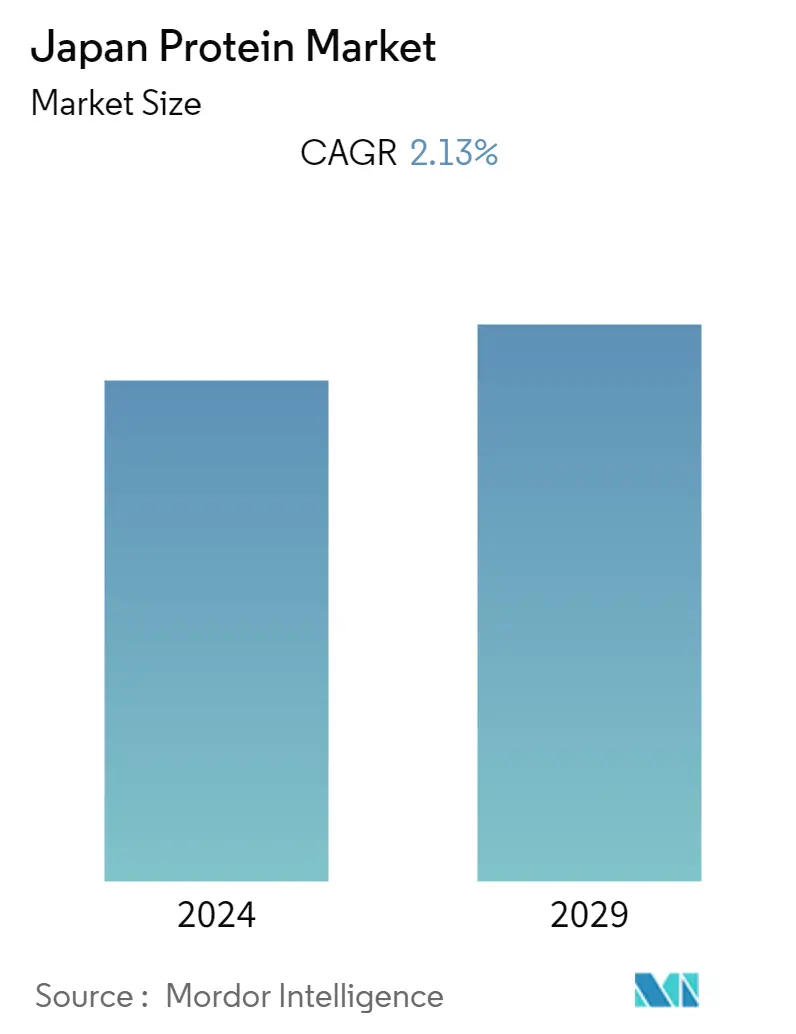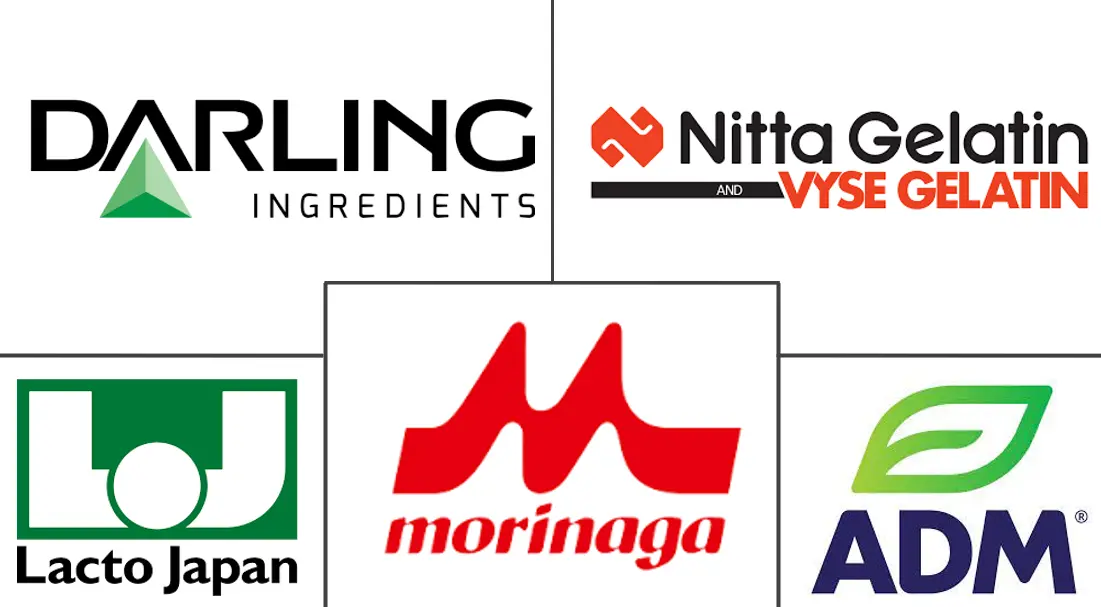Market Size of Japan Protein Industry

| Study Period | 2019 - 2029 |
| Base Year For Estimation | 2023 |
| Forecast Data Period | 2024 - 2029 |
| Historical Data Period | 2019 - 2022 |
| CAGR | 2.13 % |
| Market Concentration | Low |
Major Players
*Disclaimer: Major Players sorted in no particular order |
Japan Protein Market Analysis
The Japan protein market size is expected to grow from USD 514.72 million in 2023 to USD 571.78 million by 2028, at a CAGR of 2.13% during the forecast period (2023-2028).
- Protein demand in Japan is experiencing growth, and it is expected that this trend will continue or even accelerate in the following years, majorly due to changing dietary preferences and growing consumer awareness regarding protein intake. Japanese dietary habits have been evolving, with an increasing inclination towards a more Westernized diet. This includes a higher consumption of protein-rich foods like meat, dairy, eggs, and other plant protein sources.
- Additionally, urbanization tends to lead to changes in lifestyle and dietary patterns, often resulting in a higher demand for convenience foods, including protein-rich snacks and ready-to-eat meals. Such trends have been driving the growth in the demand for different types of protein, including meat protein, plant and microbial protein. They are driving manufacturers in the country to incorporate high protein into their products while processing.
- Also, Japan has been witnessing a surge in several vegetarian populations. This population can be divided into 3 types based on their consumption pattern: 'hidden veggies' (those who hide their vegetarianism),' 'yuruveggie' (flexitarian), and eating veggies once a week. These population groups consume plant-based proteins like soy protein and pea protein in their daily diet to compensate for animal proteins.
- Moreover, consumer's inclination towards the maintenance of personal care, including skincare and haircare, has further boosted the demand for animal-based protein ingredients like collagen, carmine, and gelatin from various personal care products manufacturers and supplement manufacturers. Manufacturers developing products with such ingredients and raising their production owing to the increasing demand are even expected to increase the usage, thus the demand for animal proteins in the country.
- For instance, in March 2023, Otsuka Pharmaceutical Co., Ltd. (Otsuka) launched a new version of EQUELLE gelée, an extension of the EQUELLE brand of supplements supporting women's health and beauty. The company claimed that its supplements include collagen and calcium that support skin and hair health.
- Furthermore, major players in the country are focused on investing in various companies that develop innovative technologies that aid in revolutionizing plant and animal-based protein production. Such developments are expected to further boost the demand for various protein ingredients in the country, which eventually drives the market's growth.
Japan Protein Industry Segmentation
Protein ingredients are derived from various animal, plant, and microbial sources that are often used to enhance the functional properties of foods, beverages, personal care products, and animal feed.
The Japan protein market is segmented based on the source and end-user. Based on the source, the market is segmented as animal, microbial, and plant. Each of these segments is sub-segmented as follows. The animal segment is sub-segmented into casein and caseinates, collagen, egg protein, gelatin, insect protein, milk protein, whey protein, and other animal protein. The microbial segment is sub-segmented into algae protein and mycoprotein. Similarly, the plant segment is sub-segmented into hemp protein, pea protein, potato protein, rice protein, soy protein, wheat protein, and other plant proteins. Based on the end-user, the market is segmented as animal feed, personal care and cosmetics, food and beverages, and supplements. The food and beverages and supplements segments are sub-segmented as follows. The food and beverages are segmented into bakery, beverages, breakfast cereals, condiments/sauces, confectionery, dairy and dairy alternative products, meat/poultry/seafood and meat alternative products, RTE/RTC food products, and snacks.
The market sizing has been done in value terms in USD and for volume terms in volume in tons for all the abovementioned segments.
| Source | ||||||||||
| ||||||||||
| ||||||||||
|
| End-User | |||||||||||
| Animal Feed | |||||||||||
| Personal Care and Cosmetics | |||||||||||
| |||||||||||
|
Japan Protein Market Size Summary
The Japan protein market is experiencing a notable expansion, driven by evolving dietary preferences and heightened consumer awareness about protein intake. As Japanese consumers increasingly adopt a Westernized diet, there is a growing demand for protein-rich foods such as meat, dairy, eggs, and plant-based sources. Urbanization and lifestyle changes are further contributing to this trend, with a rise in the consumption of convenience foods like protein-rich snacks and ready-to-eat meals. The market is also witnessing a surge in vegetarian populations, including flexitarians and those incorporating more plant-based proteins like soy and pea protein into their diets. Additionally, the demand for animal-based protein ingredients, such as collagen and gelatin, is being bolstered by the personal care industry, which seeks to cater to consumers' skincare and haircare needs. This dynamic landscape is prompting manufacturers to innovate and expand their product offerings to meet the growing demand for both plant and animal-based proteins.
The market's growth is further supported by the increasing popularity of plant-based protein sources, driven by environmental concerns and the availability of diverse options like soy and pea protein. Consumers' familiarity with soy-based products, such as tofu and soymilk, has facilitated the acceptance of plant-based proteins in Japan. This shift has led to significant investments in alternative protein technologies, enhancing the texture and nutritional profile of plant-based foods. The introduction of innovative plant protein-based meat alternatives, such as plant-based hamburgers and gyoza dumplings, is catering to consumers accustomed to a meat-rich diet. The market is characterized by a fragmented landscape with key players like Archer Daniels Midland Company and Lacto Japan Co., Ltd. actively engaging in strategic partnerships, capacity expansions, and product innovations to maintain a competitive edge. These developments are expected to sustain the market's growth trajectory, driven by the increasing demand for protein ingredients across various sectors, including food, beverages, and personal care.
Japan Protein Market Size - Table of Contents
-
1. MARKET DYNAMICS
-
1.1 Market Drivers
-
1.1.1 Growing Health and Fitness Consciousness Among Japanese
-
1.1.2 Increasing Demand for Meat Analogues
-
-
1.2 Market Restraints
-
1.2.1 Higher Production Costs and Limited Capacities
-
-
1.3 Industry Attractiveness - Porter's Five Forces Analysis
-
1.3.1 Bargaining Power of Suppliers
-
1.3.2 Bargaining Power of Buyers
-
1.3.3 Threat of New Entrants
-
1.3.4 Threat of Substitute Products and Services
-
1.3.5 Intensity of Competitive Rivalry
-
-
-
2. Market Segmentation
-
2.1 Source
-
2.1.1 Animal
-
2.1.1.1 Casein and Caseinates
-
2.1.1.2 Collagen
-
2.1.1.3 Egg Protein
-
2.1.1.4 Gelatin
-
2.1.1.5 Insect Protein
-
2.1.1.6 Milk Protein
-
2.1.1.7 Whey Protein
-
2.1.1.8 Other Animal Protein
-
-
2.1.2 Microbial
-
2.1.2.1 Algae Protein
-
2.1.2.2 Mycoprotein
-
-
2.1.3 Plant
-
2.1.3.1 Hemp Protein
-
2.1.3.2 Pea Protein
-
2.1.3.3 Potato Protein
-
2.1.3.4 Rice Protein
-
2.1.3.5 Soy Protein
-
2.1.3.6 Wheat Protein
-
2.1.3.7 Other Plant Protein
-
-
-
2.2 End-User
-
2.2.1 Animal Feed
-
2.2.2 Personal Care and Cosmetics
-
2.2.3 Food and Beverages
-
2.2.3.1 Bakery
-
2.2.3.2 Beverages
-
2.2.3.3 Breakfast Cereals
-
2.2.3.4 Condiments/Sauces
-
2.2.3.5 Confectionery
-
2.2.3.6 Dairy and Dairy Alternative Products
-
2.2.3.7 Meat/Poultry/Seafood and Meat Alternative Products
-
2.2.3.8 RTE/RTC Food Products
-
2.2.3.9 Snacks
-
-
2.2.4 Supplements
-
2.2.4.1 Baby Food and Infant Formula
-
2.2.4.2 Elderly Nutrition and Medical Nutrition
-
2.2.4.3 Sport/Performance Nutrition
-
-
-
Japan Protein Market Size FAQs
What is the current Japan Protein Market size?
The Japan Protein Market is projected to register a CAGR of 2.13% during the forecast period (2024-2029)
Who are the key players in Japan Protein Market?
Lacto Japan Co., Ltd., Morinaga Milk Industry Co., Ltd., Nitta Gelatin, Inc., Darling Ingredients Inc. and Archer Daniels Midland Company are the major companies operating in the Japan Protein Market.

